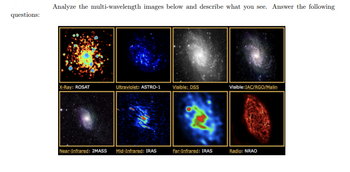Question
thumb_up100%
Analyze the multi-wavelength images below and describe what you see. Answer the following
questions:

Transcribed Image Text:questions:
Analyze the multi-wavelength images below and describe what you see. Answer the following
X-Ray: ROSAT
Ultraviolet:ASTRO-1 Visible: DSS
Near-Infrared: 2MASS Mid-Infrared: IRAS
Far-Infrared: IRAS
Visible:IAC/RGO/Malin
Radio: NRAO

Transcribed Image Text:1. What type of astrophysical object is imaged?
2. Where do you see the higher energy phenomena? What are they? Are they visible in any image? Why?
3. Where are the young stars? What colour do they have? Are they visible in any image? Why?
4. Where are the old stars? What colour do they have? Are they visible in any image? Why?
5. What is responsible for the emission observed in the Far-Infrared image? Briefly explain why we observe
this emission.
Expert Solution
This question has been solved!
Explore an expertly crafted, step-by-step solution for a thorough understanding of key concepts.
Step by stepSolved in 2 steps

Knowledge Booster
Similar questions
- For a human eye with a pupil diameter (aperture diameter D) of 0.005 meters, and a focal length of 0.022 meters, there will be a resolution limit due to diffraction at 0.6 microns (10^-6 meters) wavelength. If we space light-sensitive cells on the retina at this spacing, how many retina cells per meter (of retina) are there? cells/meter. Now suppose there are giants which are exactly twice the size of humans in each dimension. So giant eyes have pupils of 0.01 meters, and a focal length of 0.044 meters. How many retina cells per meter should the giants have? cells/meterarrow_forwardIn order to observe emissions from celestial bodies Very Long Baseline Arrays (VLBA) have been developed. Explain why VLBA use multiple telescopes separated by long distances in terms of the wave nature of light. Include in your answer specific physics terminology, associated relevant equations, and a labelled diagram.arrow_forwardwhat three astronomical objects are represented on this excerpted Image 1 from a postage stamp? What are the two rings?arrow_forward